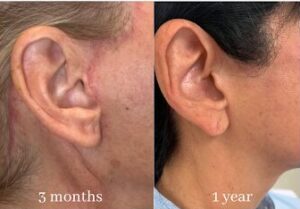The phrase “ponytail facelift” has been trending on social media recently because of its lessened recovery time. At its core, a ponytail facelift is a marketing term for a less-invasive facelift, which is also called a mini or weekend facelift that does not include the neck.
In this guide, we’ll delve into the details of the ponytail facelift, discussing what it is, the cost, why we prefer to perform deep plane facelift surgery, and more.
What is a Ponytail Facelift?
Contrary to popular belief, ponytail facelift is not a medical term. It actually has two meanings. Firstly, it derives from the idea that you could wear your hair in a ponytail immediately after the procedure, thanks to the hidden incisions and reduced swelling. Secondly, the results of a ponytail facelift mimic the look of having your hair in a high, tight ponytail.
This procedure typically targets the lower two-thirds of the face, focusing on the midface, jawline, and jowls, to create a more youthful and refreshed appearance.
View this post on Instagram
How Much Does a Ponytail Facelift Cost?
On average, a ponytail facelift may range from $10,000 to $15,000.
The cost of a ponytail facelift can vary depending on several factors, including the geographical location of the surgical facility, the expertise of the surgeon, the extent of the procedure, and any additional fees for anesthesia and facility usage. This procedure costs less than the cost of a deep plane facelift because it’s much shorter and less invasive not involving the neck.
Keep in mind that the price may also vary based on the specific technique used and the individual goals of the patient. Some patients may opt for additional treatments or procedures alongside their ponytail facelift such as eyelid surgery or an eyebrow lift, which can affect the overall cost.
Before committing to the procedure, it’s essential to schedule a consultation with a board-certified facial plastic surgeon. During this consultation, the surgeon will assess your unique needs and provide a detailed cost estimate based on your specific goals and circumstances.
In addition, it’s important to consider that the cost of a ponytail facelift includes not just the surgery itself but also preoperative consultations, post-operative follow-up appointments, and any necessary aftercare. Be sure to inquire about any potential hidden costs during your initial consultation to have a clear understanding of the overall financial commitment.
Why We Prefer to Perform an Extended Deep Plane Facelift Surgery on Most Patients Seeking Facial Rejuvenation
At The Williams Center, we perform the extended deep plane facelift because the results last longer than a ponytail facelift. An extended deep plane facelift includes the neck and lower two-thirds of the mid-face and jawline. Addressing these areas is critical as the deep tissues in the face are lifted during an extended deep plane facelift, resulting in a more defined jawline, cheekbone, and neck area.
Patients tend to have a more natural look rather than a “pulled” look. The deep plane facelift can also restore volume to the mid-face and under-eye areas to give patients fuller cheeks and a more youthful appearance.
It is also a more transparent name for the procedure – terms like “ponytail facelift” are marketing terms that don’t offer information on the actual medical procedure.
Our facelifts are customized to each patient and their desired results. During your consultation, your facial plastic surgeon will walk through your options and their recommendations.
Ponytail Facelift vs. Deep Plane Facelift
At The Williams Center, we prefer the deep plane facelift because results last decades longer than a less invasive facelift. There are many key differences between a deep plane facelift and a ponytail facelift, or mini facelift.
Invasiveness: Deep Plane Facelift vs. Ponytail Facelift
Deep Plane Facelift: A deep plane facelift involves more extensive surgery and therefore more natural and longer lasting results. It often requires general anesthesia and longer incisions that typically start near the temples and extend around the ears. The surgeon lifts and repositions the underlying tissues and muscles, removes excess skin, and tightens the remaining skin. This procedure provides comprehensive rejuvenation of the entire face and neck.
A true deep plane facelift is very technically demanding, which is why many surgeons do not perform the procedure.
Ponytail Facelift: A less-invasive facelift can be performed under sedation. The incisions are shorter, typically limited to the front of the ears or behind them. The surgeon lifts and tightens the skin and underlying tissues, which yields more subtle results.
Recovery Time: Deep Plane Facelift vs. Ponytail Facelift
Deep Plane Facelift: Recovery from a deep plane facelift can take a few weeks, with visible swelling and bruising that may require patients to stay home during the initial stages of healing. The results are long-lasting and provide more significant facial rejuvenation.
Ponytail Facelift: The recovery time for a ponytail facelift is typically shorter, often just a few days to a week. Swelling and bruising are less pronounced, and many patients can return to their daily routines sooner. While the results are more subtle, the convenience of a quicker recovery is a significant appeal for some individuals.
Ideal Patients: Deep Plane Facelift vs. Ponytail Facelift
Deep Plane Facelift: Deep plane facelifts are suitable for patients seeking comprehensive facial rejuvenation, often with more advanced signs of aging, such as severe sagging of the neck and deep wrinkles. It is a better choice for those willing to commit to a longer recovery for more dramatic results that will last decades.
Ponytail Facelift: The ponytail facelift is ideal for younger patients with early to moderate signs of aging, such as mild sagging, jowls, and fine lines. It is an excellent option for those who want to refresh their appearance without the downtime and cost associated with a full facelift.
Will My Scars Be Visible After a Ponytail Facelift?
One of the most common concerns when considering any type of facelift is the visibility of post-operative scars.
In a ponytail facelift, incisions are placed around or in front of the ears, and they are concealed within the natural contours of the face. The goal is to keep scarring minimal and discreet, ensuring that it is not easily noticeable. Over time, the scars tend to fade and become less visible, especially with proper post-operative care and sun protection.
For patients who undergo deep plane facelift surgery, the incision scars will eventually fade and become nearly invisible. Until that happens, you can expect that the scars will be pinkish for six months or so.
It’s essential to discuss scarring concerns with your surgeon during the consultation phase. An experienced and skilled surgeon will take steps to ensure that the incisions are as inconspicuous as possible and provide guidance on post-operative scar care.
Is a Ponytail Facelift Right For Me?
The ponytail facelift, although less-invasive, might not be the best option for you if you’re looking for longer-lasting results.
When considering a facelift, it’s essential to consult with an experienced facial plastic surgeon to determine if it’s the right procedure for your unique needs and goals. Address any concerns you have regarding scarring and cost during your consultations to ensure that you are well-informed and comfortable with your decision. With the right surgeon and thorough preparation, you can embark on your journey to a more youthful and confident you.

